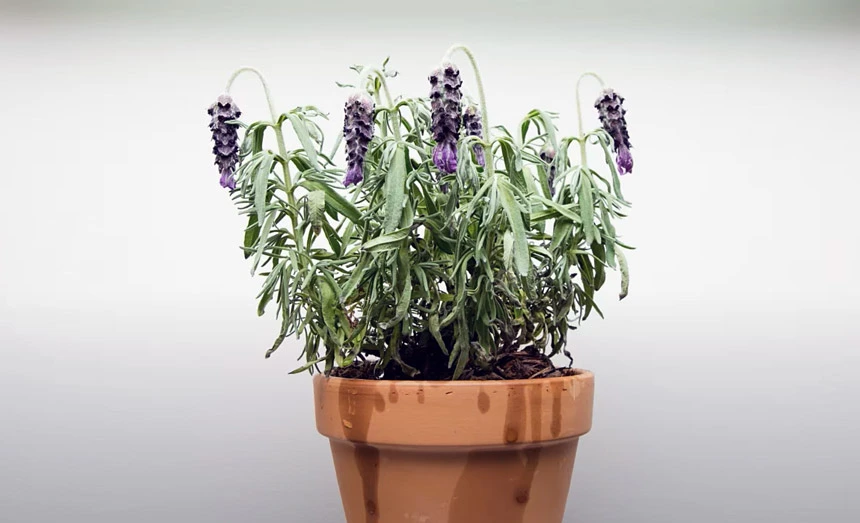Lavender (Lavandula) is a popular shrub known for its fragrant flowers and foliage. Though often considered a perennial, lavender is an herbaceous plant that blooms for only a few weeks each year. Once the blooming period is over, the plant enters a dormant state until the following spring.
I spend a lot of time on garden forums. And one of the most common questions I see is, “Why is my lavender wilting?”
Lavender wilting is a common problem. The leaves of the plant turn brown and dry, and the stems become weak and brittle. This can be caused by several different things, including too much sun, too little water, or a nutrient deficiency. Sometimes, lavender wilting is simply due to old age.
Our horticultural experts have put together this article to help you identify the cause of your lavender wilting and what you can do to fix the problem. Keep reading to learn more about lavender wilting and how to keep your plant healthy and hydrated.
Lavender wilting due to drought
Drought is like a natural disaster. When conditions are hot and dry, and there is little or no water available, lavender wilting can occur. The plant leaves will first turn yellow, then brown and crisp. The flowers will also wilt, and the plant may eventually die.
You can do a few things to try and save your lavender plant if it is wilting from drought. First, try to give the plant some water. This can be done by hand, with a watering can, or with a hose. Make sure you soak the roots of the plant thoroughly. Secondly, try to mulch the plant.
This will help retain moisture in the soil and prevent evaporation. Finally, if possible, try to shade the plant from the sun. This will help reduce the amount of water the plant loses through evaporation.
If you take these steps and the lavender plant does not recover, it has likely died. Drought is a very difficult condition to overcome, even for experienced gardeners. If you live in an area prone to drought, it is important to be prepared. Try to choose drought-tolerant plants for your garden, and make sure you have a plan to water them if the conditions arise.
Lavender Wilting After Planting
Planting new lavender increases the rate of wilting due to the plant being in a new environment and adapting to the new conditions. The planting process can also damage the roots, leading to wilting. Causes of wilting after planting include:
1. Improper planting
When planting lavender, it is important to do so properly to avoid wilting. Improper planting can include planting the lavender too deep, not watering it enough, or planting it in an area that does not get enough sunlight. If the lavender is not planted properly, the roots may not be able to take in enough water or nutrients, which can lead to wilting.
2. Transplant shock
Transplant shock is another common cause of wilting in lavender. Transplant shock occurs when a plant is moved from one location to another, and the roots are damaged. This damage can cause the plant to be unable to take in enough water, leading to wilting.
3. Water Immediately After planting
It is important to water the lavender immediately after planting. This will help the plant to recover from any damage that was done during the planting process and will also help to prevent transplant shock. Watering should be done generously so that the roots are completely soaked.
Lavender Wilting due to high acidic levels in the soil
Lavender plants are a beautiful addition to any garden, but if your lavender is wilting, it may be due to high acidic levels in the soil. This can be a problem in gardens adjacent to areas with lots of concrete, as the runoff from the concrete can increase the soil’s acidity. There are a few things you can do to help mitigate this problem:
1. Add organic matter to the soil
Adding organic matter to the soil is a great way to help increase the acidity levels and improve the overall health of your lavender plants. You can add many different organic materials, including compost, manure, or leaf mold. Adding organic matter will also help improve the structure of the soil and increase its ability to hold water and nutrients.
2. Apply a lime amendment
Another way to help reduce the soil’s acidity is to apply a lime amendment. This can be done by spreading a layer of lime over the surface of the soil or by adding it to the watering can and applying it to the base of the plants. Lime amendments can be found at most garden centers or online.
3. Choose a different location
If the soil in your garden is naturally high in acidity, you may want to consider choosing a different location for your lavender plants. If possible, try to find an area that has well-drained, neutral to alkaline soil. This will help ensure that your plants are able to thrive.
Lavender wilting for over-watered soil
Overwatered soil is one of the primary reasons why lavender wilts. When the roots of the plant sit in water, they cannot get the oxygen they need to function properly. This causes the leaves to wilt and eventually die.
If you think your lavender is wilting due to overwatering, check the soil before watering again. If it’s moist, wait a few days to see if the plant recovers. If not, give it a thorough watering, then let the soil dry out completely before watering again.
Lavender wilting for Over-nourishment of the Soil
Over-nourishment of the soil is one of the main reasons why lavender wilts. When the soil contains too much nitrogen, it causes the leaves to become weak and eventually fall off.
The best way to avoid this is to fertilize your lavender plants with a balanced fertilizer that contains equal parts of nitrogen, phosphorus, and potassium. You should also ensure that you water your lavender plants regularly, so the soil does not become too dry.
Lavender wilting due to lack of soil nutrients
Lack of proper nutrition is one of the causes of lavender wilting. The soil may not have enough necessary nutrients for the plant to thrive. This can be caused by poor quality soil, incorrect fertilizer application, or simply insufficient nutrients in the soil.
1. Poor quality soil
One possible explanation for the wilting of your lavender is that the soil it is planted in is poor quality. This could be due to a lack of nutrients or drainage, preventing the plant from getting the resources it needs to thrive. You may need to amend the soil with some organic material or fertilizer to help improve the condition.
2. Incorrect fertilizer application
When it comes to incorrect fertilizer applications, there are a few things that can go wrong. One common mistake is applying too much fertilizer at once, which can burn the plant’s roots.
Another mistake is using the wrong type of fertilizer for the plant’s needs; for example, using a nitrogen-rich fertilizer on a plant that prefers phosphorus-rich soil. Fertilizers should also be applied at the correct time of year; for example, plants that bloom in the summer should not be fertilized until after they have finished blooming.
Lavender wilting for Planting in a Small Pot
Small pots can be bad for lavender since the roots won’t have enough space to grow. The key to a healthy lavender plant in a small pot is drainage. If you don’t have good drainage, your plant will quickly become waterlogged and die.
1. Move the Plant to a Bigger Pot
When a plant’s roots become cramped, they stop growing, and the plant begins to wilt. A simple solution is to move the plant to a bigger pot. This will give the roots more space to grow, and the plant will recover health.
Over-pruning can cause lavender to wilt.
Over-pruning can cause lavender plants to wilt and die. This is because when you prune a plant too much, you are removing the parts of the plant that help it to grow and thrive. In the case of lavender, over-pruning can remove the flower buds, impacting the plant’s ability to produce flowers.
Over-pruning can also remove the leaves, which the plant needs for photosynthesis. Without leaves, the plant cannot produce the food it needs to survive.
If you have over-pruned your lavender plant, it is important to take action quickly to save the plant. First, cut back on watering to allow the plant to recover from the stress of over-pruning.
Second, fertilize the plant with a high-phosphorus fertilizer to help it regain its strength. Finally, give the plant plenty of sunlight to help it produce food. With proper care, your lavender plant should be able to recover from over-pruning and continue to thrive.
The disease can cause lavender to wilt.
The disease can be a common cause of lavender wilting. Examples of diseases that can affect lavenders include root rot, crown rot, and powdery mildew. These diseases can cause the plant to wilt and die.
1. Lavender root rot causes wilting
Lavender root rot is a serious disease that can cause lavender plants to wilt and die. The disease is caused by a fungus that infects the plant’s roots. The fungus damages the plant’s roots, which prevents them from getting the nutrients they need to survive. This can cause the plants to wilt and die.
2. Lavender crown rot can also cause wilting
Lavender crown rot is another disease that can cause lavenders to wilt and die. This disease is caused by a fungus that attacks the plant’s leaves and stems. The fungus damages the plants’ leaves and stems, which prevents them from getting the nutrients they need to survive. This can cause the plants to wilt and die.
3. Powdery mildew can also cause lavenders to wilt
Powdery mildew is another disease that can affect lavenders. This disease is caused by a fungus that attacks the plant’s leaves and stems. The fungus covers the plants’ leaves and stems with a white powdery substance. This can cause the plants to wilt and die.
There are several ways to prevent diseases from affecting lavenders. One way is to plant disease-resistant varieties of lavender. Another way is to properly water the plants and keep the surrounding area clean and debris-free. If a disease does occur, it is important to treat it promptly and appropriately.
Lavender Wilting Due to Pests
Pests can be a major problem for lavender plants. Aphids, mites, and thrips are all common lavender pests that can cause wilting.
These pests can suck the sap out of plants, leading to dehydration and wilting. In addition to wilting, you may also see damage to the leaves or buds of your lavender plants.
If you suspect that pests are causing your lavender to wilt, check the plants carefully for signs of these pests. If you find any, you’ll need to take steps to get rid of them before they cause further damage to your plants.
Conclusion
As you can see, there are several reasons your lavender might be wilting. Over-pruning, disease, and pests are all common causes of lavender wilting.
If you suspect that one of these is causing your lavender to wilt, take action quickly to save the plant. With proper care, your lavender should be able to recover and continue to thrive.


